TOYOTA iA 2016 Owners Manual (in English)
Manufacturer: TOYOTA, Model Year: 2016, Model line: iA, Model: TOYOTA iA 2016Pages: 588, PDF Size: 5.15 MB
Page 131 of 588
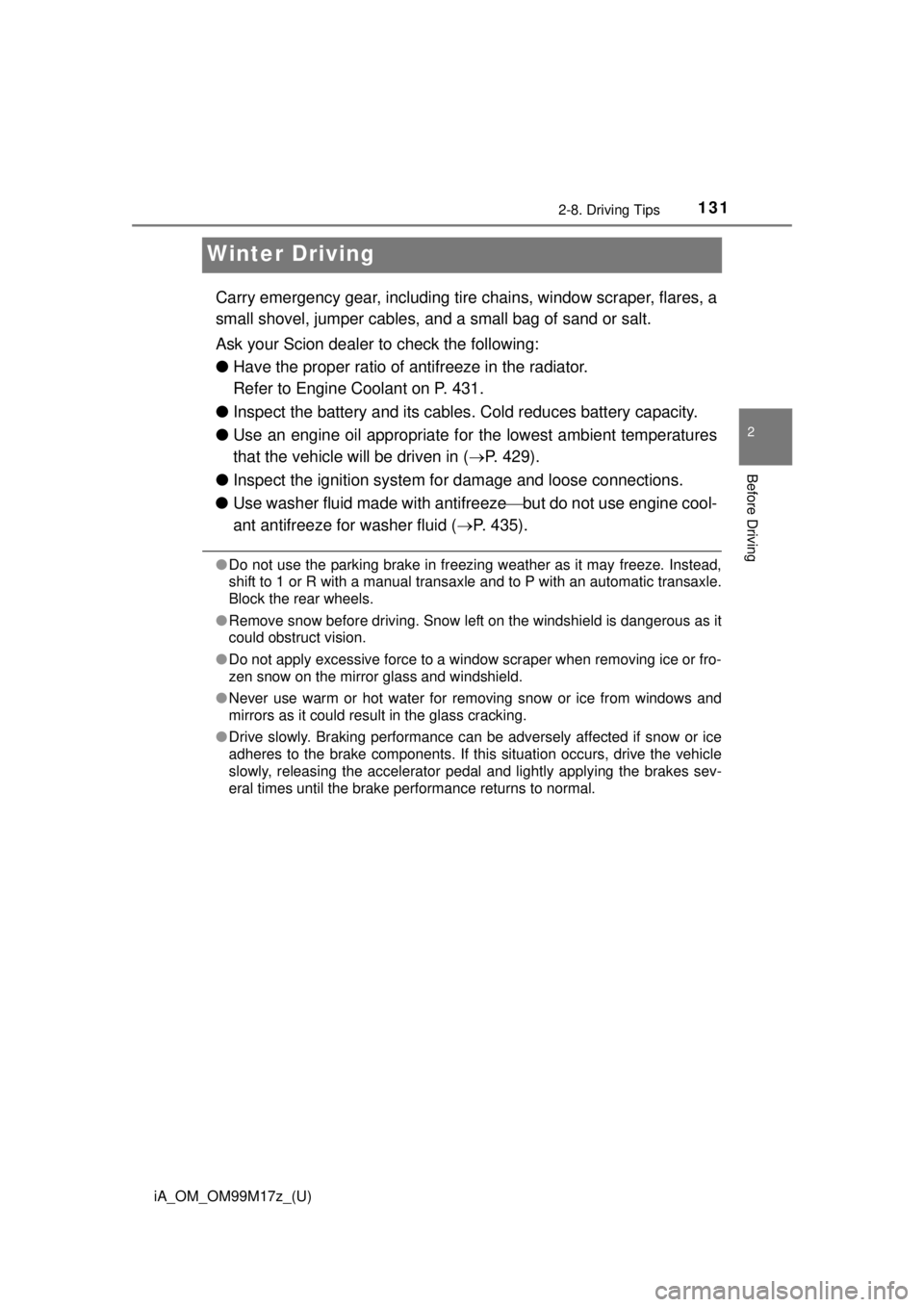
131
iA_OM_OM99M17z_(U)
2-8. Driving Tips
2
Before Driving
Winter Driving
Carry emergency gear, including tire chains, window scraper, flares, a
small shovel, jumper cables, a nd a small bag of sand or salt.
Ask your Scion dealer to check the following:
● Have the proper ratio of antifreeze in the radiator.
Refer to Engine Coolant on P. 431.
● Inspect the battery and its cables . Cold reduces battery capacity.
● Use an engine oil appropriate for the lowest ambient temperatures
that the vehicle will be driven in ( P. 429).
● Inspect the ignition sy stem for damage and loose connections.
● Use washer fluid made with antifreeze but do not use engine cool-
ant antifreeze for washer fluid ( P. 435).
●Do not use the parking brake in freezing weather as it may freeze. Instead,
shift to 1 or R with a manual transaxle and to P with an automatic transaxle.
Block the rear wheels.
● Remove snow before driving. Snow left on the windshield is dangerous as it
could obstruct vision.
● Do not apply excessive force to a window scraper when removing ice or fro-
zen snow on the mirror glass and windshield.
● Never use warm or hot water for removing snow or ice from windows and
mirrors as it could result in the glass cracking.
● Drive slowly. Braking performance can be adversely affected if snow or ice
adheres to the brake components. If this situation occurs, drive the vehicle
slowly, releasing the accelerator pedal and lightly applying the brakes sev-
eral times until the brake performance returns to normal.
Page 132 of 588
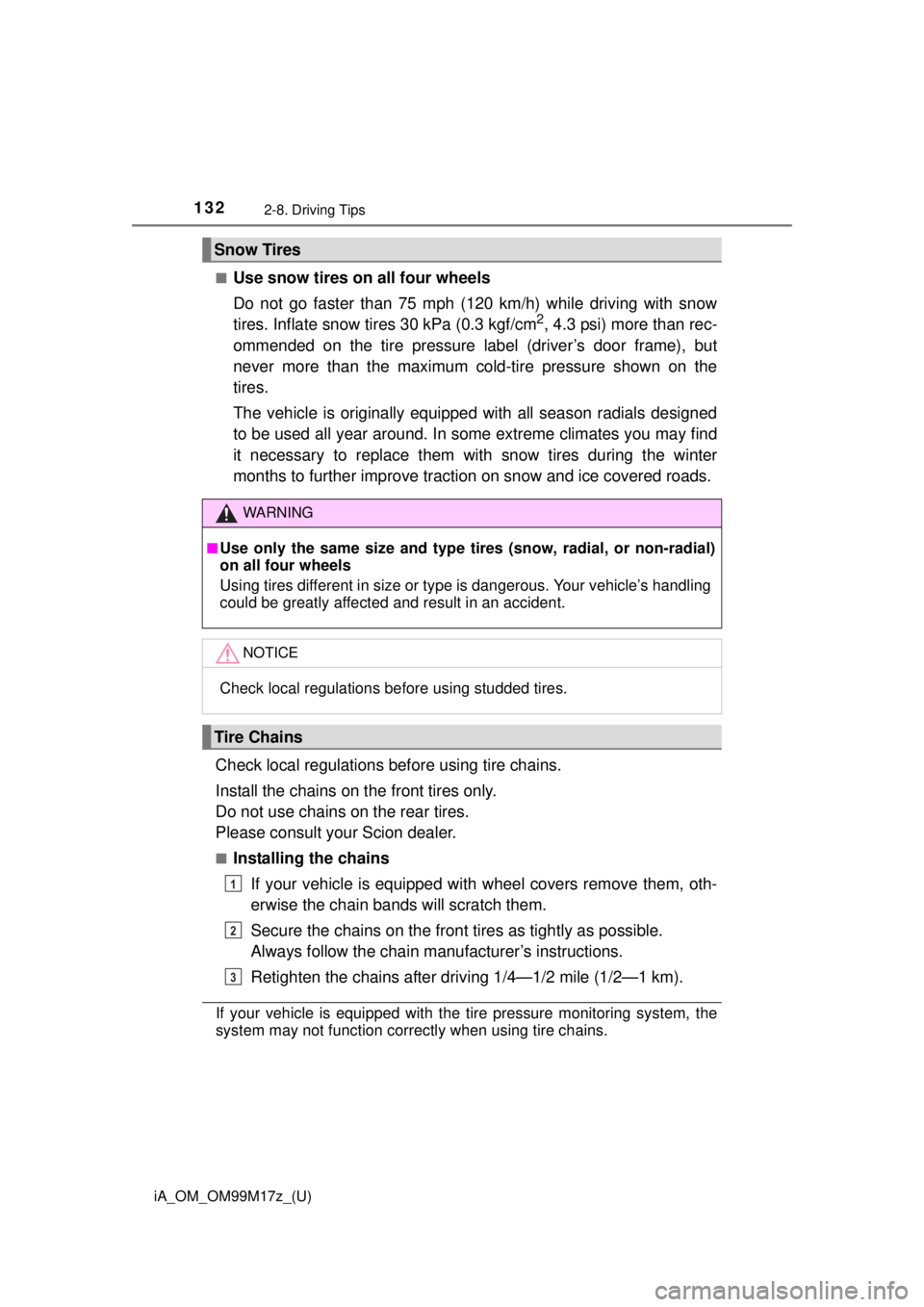
132
iA_OM_OM99M17z_(U)
2-8. Driving Tips
■Use snow tires on all four wheels
Do not go faster than 75 mph (120 km/h) while driving with snow
tires. Inflate snow tires 30 kPa (0.3 kgf/cm
2, 4.3 psi) more than rec-
ommended on the tire pressure label (driver’s door frame), but
never more than the maximum cold-tire pressure shown on the
tires.
The vehicle is originally equipped with all season radials designed
to be used all year around. In some extreme climates you may find
it necessary to replace them with snow tires during the winter
months to further improve traction on snow and ice covered roads.
Check local regulations bef ore using tire chains.
Install the chains on the front tires only.
Do not use chains on the rear tires.
Please consult your Scion dealer.
■Installing the chains If your vehicle is equipped with wheel covers remove them, oth-
erwise the chain bands will scratch them.
Secure the chains on the front tires as tightly as possible.
Always follow the chain manufacturer’s instructions.
Retighten the chains after driving 1/4—1/2 mile (1/2—1 km).
If your vehicle is equipped with the tire pressure monitoring system, the
system may not function correctly when using tire chains.
Snow Tires
WARNING
■Use only the same size and type tires (snow, radial, or non-radial)
on all four wheels
Using tires different in size or type is dangerous. Your vehicle’s handling
could be greatly affected and result in an accident.
NOTICE
Check local regulations before using studded tires.
Tire Chains
1
2
3
Page 133 of 588
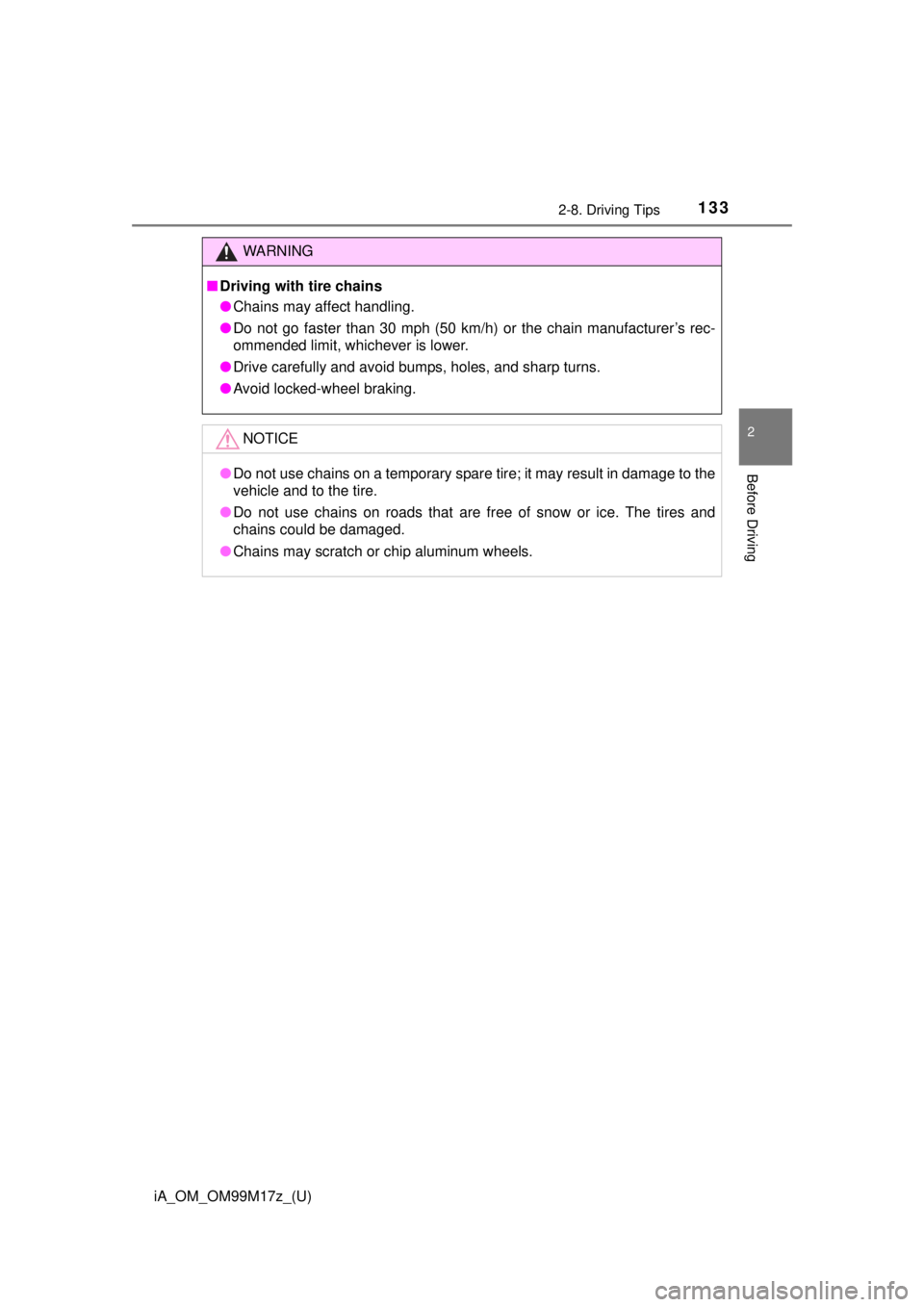
iA_OM_OM99M17z_(U)
1332-8. Driving Tips
2
Before Driving
WARNING
■Driving with tire chains
● Chains may affect handling.
● Do not go faster than 30 mph (50 km/h) or the chain manufacturer’s rec-
ommended limit, whichever is lower.
● Drive carefully and avoid bumps, holes, and sharp turns.
● Avoid locked-wheel braking.
NOTICE
●Do not use chains on a temporary spare tire; it may result in damage to the
vehicle and to the tire.
● Do not use chains on roads that are free of snow or ice. The tires and
chains could be damaged.
● Chains may scratch or chip aluminum wheels.
Page 134 of 588
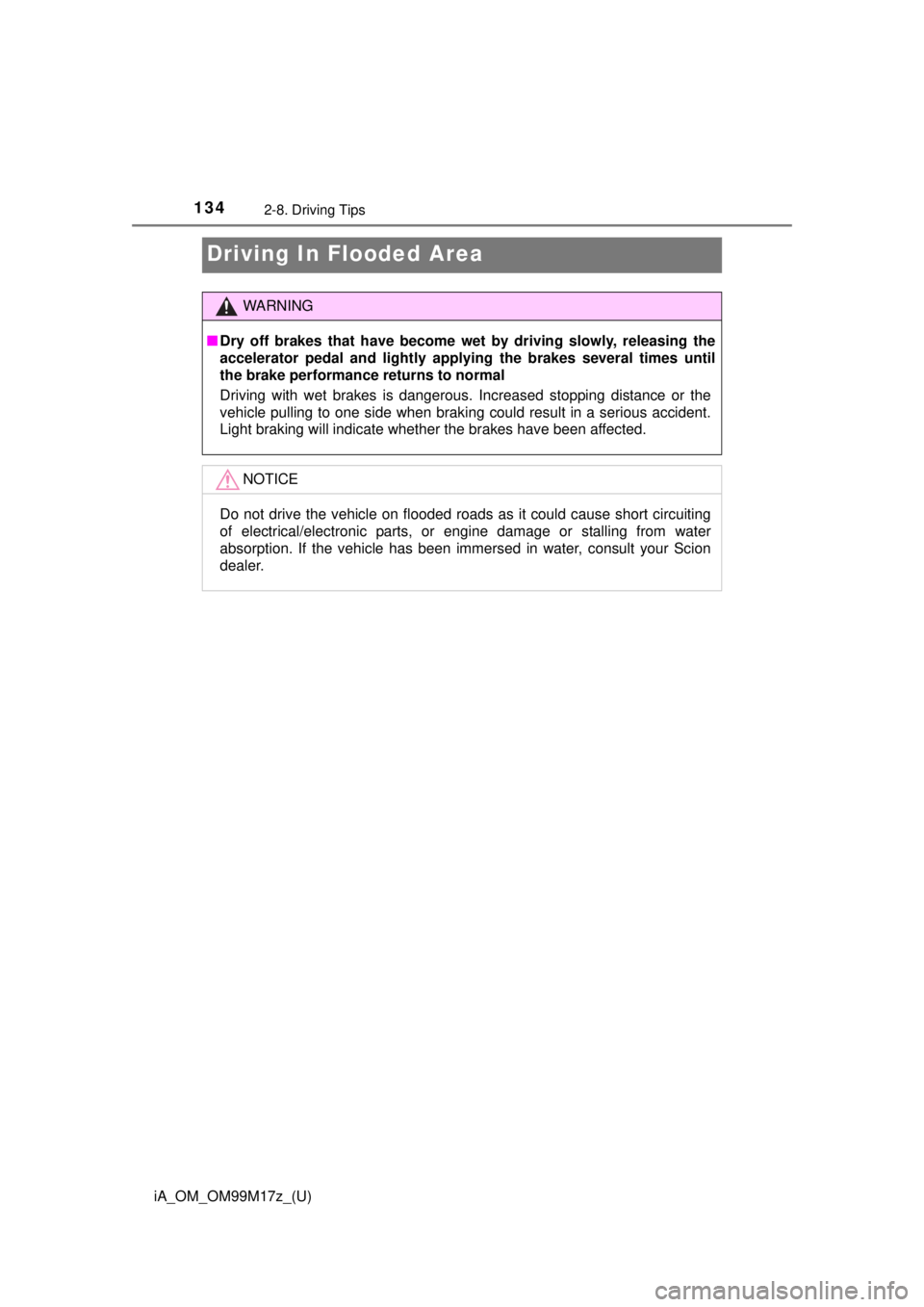
134
iA_OM_OM99M17z_(U)
2-8. Driving Tips
Driving In Flooded Area
WARNING
■Dry off brakes that have become wet by driving slowly, releasing the
accelerator pedal and lightly applyi ng the brakes several times until
the brake performance returns to normal
Driving with wet brakes is dangerous . Increased stopping distance or the
vehicle pulling to one side when braking could result in a serious accident.
Light braking will indicate whether the brakes have been affected.
NOTICE
Do not drive the vehicle on flooded roads as it could cause short circuiting
of electrical/electronic parts, or engine damage or stalling from water
absorption. If the vehicle has been immersed in water, consult your Scion
dealer.
Page 135 of 588

135
iA_OM_OM99M17z_(U)
2-8. Driving Tips
2
Before Driving
Overloading
WARNING
■Be careful not to overload your vehicle
The gross axle weight rating (GAWR) and the gross vehicle weight rat-
ing (GVWR) of the vehicle are on the Motor Vehicle Safety Standard
Label on the driver’s door frame. Exceeding these ratings can cause an
accident or vehicle damage. You can estimate the weight of the load by
weighing the items (or people) be fore putting them in the vehicle.
Page 136 of 588
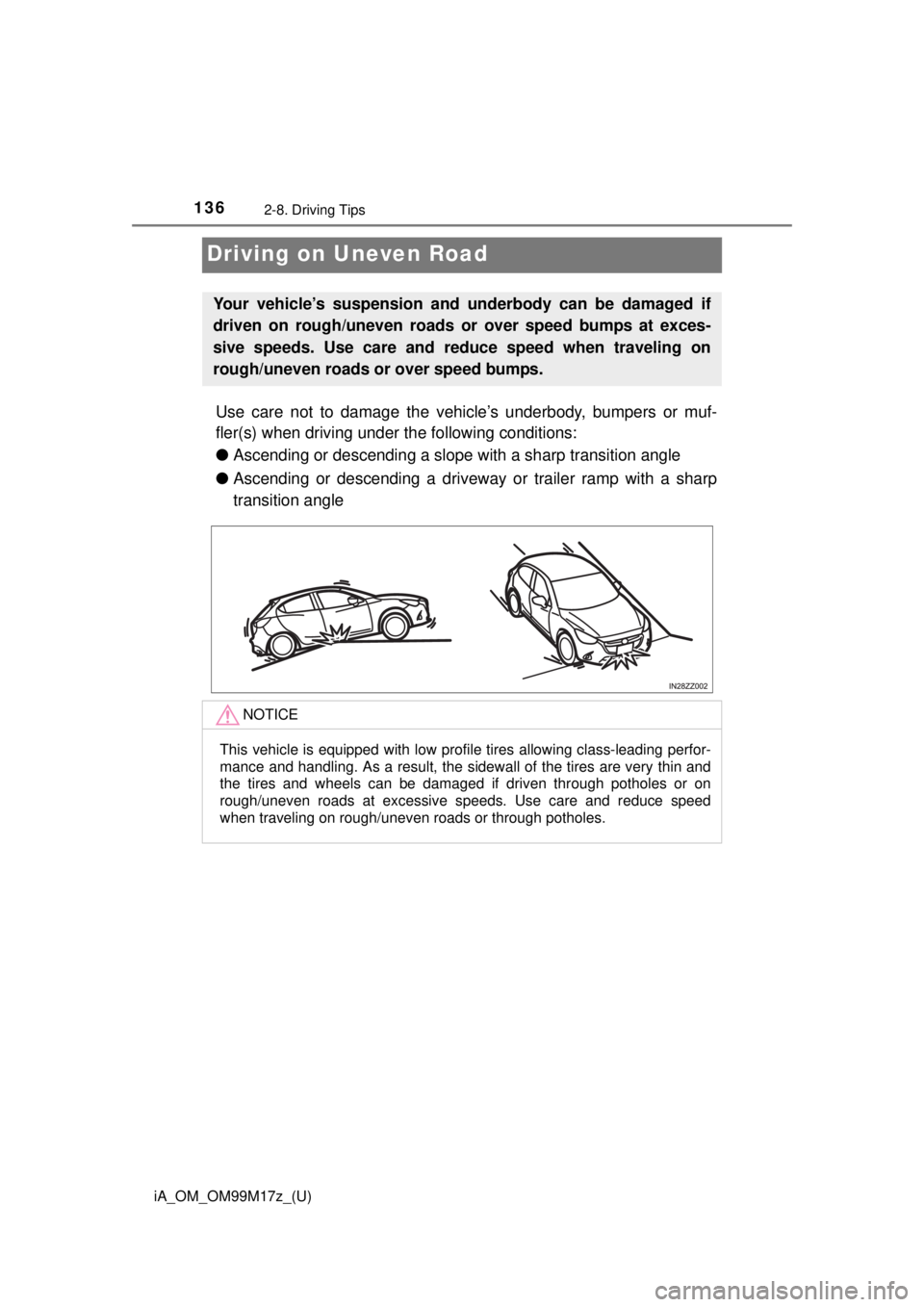
136
iA_OM_OM99M17z_(U)
2-8. Driving Tips
Driving on Uneven Road
Use care not to damage the vehicle’s underbody, bumpers or muf-
fler(s) when driving under the following conditions:
● Ascending or descending a slope with a sharp transition angle
● Ascending or descending a driveway or trailer ramp with a sharp
transition angle
Your vehicle’s suspension and underbody can be damaged if
driven on rough/uneven roads or over speed bumps at exces-
sive speeds. Use care and reduce speed when traveling on
rough/uneven roads or over speed bumps.
NOTICE
This vehicle is equipped with low profile tires allowing class-leading p\
erfor-
mance and handling. As a result, the sidewall of the tires are very thin and
the tires and wheels can be damaged if driven through potholes or on
rough/uneven roads at excessive speeds. Use care and reduce speed
when traveling on rough/uneven roads or through potholes.
Page 137 of 588
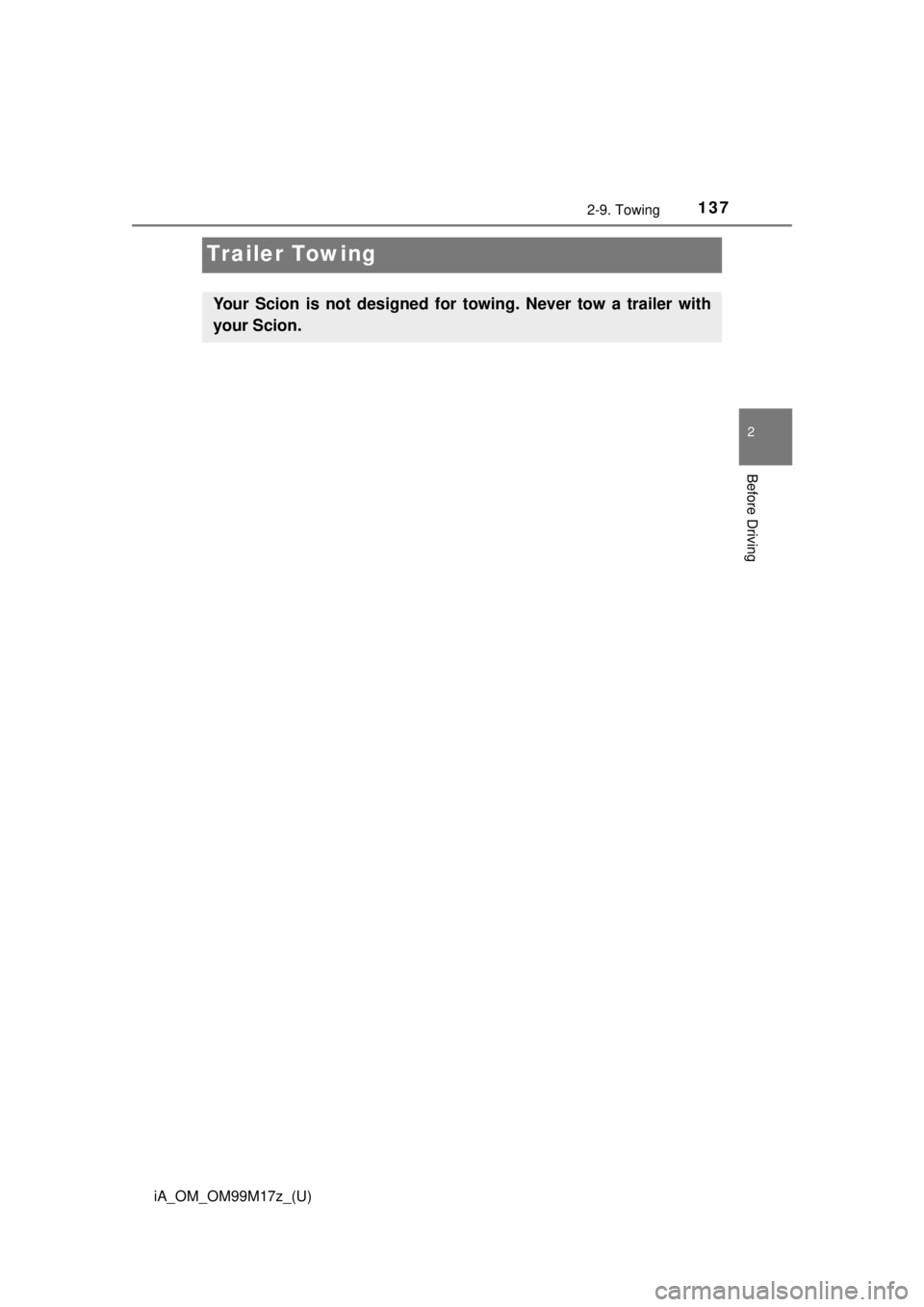
137
iA_OM_OM99M17z_(U)
2-9. Towing
2
Before Driving
Trailer Towing
Your Scion is not designed for towing. Never tow a trailer with
your Scion.
Page 138 of 588
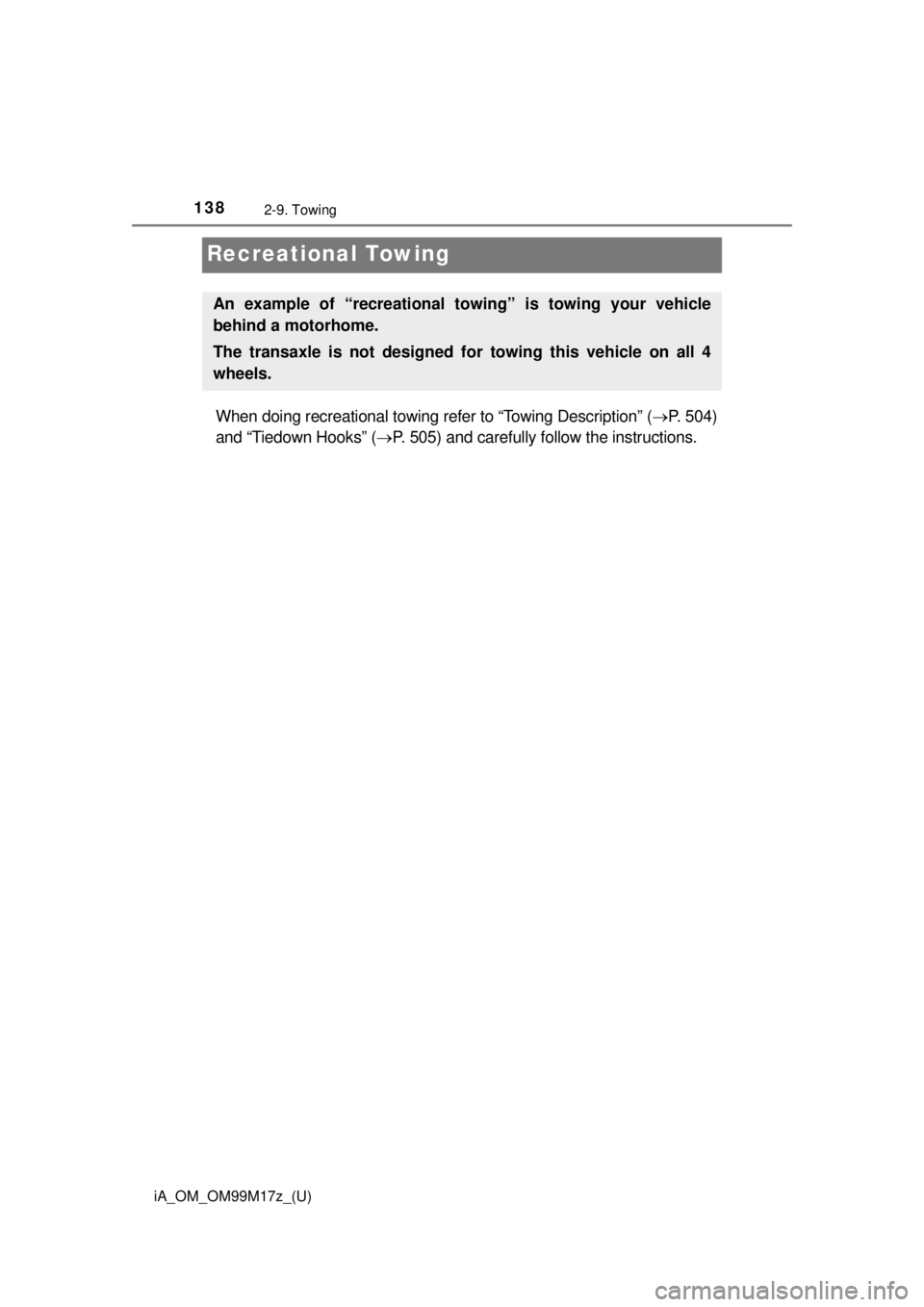
138
iA_OM_OM99M17z_(U)
2-9. Towing
Recreational Towing
When doing recreational towing refer to “Towing Description” (P. 504)
and “Tiedown Hooks” ( P. 505) and carefully follow the instructions.
An example of “recreational to wing” is towing your vehicle
behind a motorhome.
The transaxle is not designed for towing this vehicle on all 4
wheels.
Page 139 of 588

139
iA_OM_OM99M17z_(U)
3When Driving
3-1. Start/Stop EngineIgnition Switch ................... 140
Starting the Engine ........... 142
Turning the Engine Off ...... 147
3-2. Combination Meter and Display
Meters and Gauges .......... 148
Warning/Indicator Lights .............................. 156
3-3. Transaxle Manual Transaxle Operation ........................ 160
Automatic Transaxle Controls........................... 164
3-4. Switches and Controls Lighting Control ................. 175
Fog Lights ......................... 179
Turn and Lane-Change Signals ............................ 180
Windshield Wipers and Washer..................... 182
Rear Window Defogger ......................... 185
Hazard Warning Flasher ............................ 186
3-5. Brake Brake System .................... 187
Hill Launch Assist (HLA) ... 191 3-6. ABS/TCS/DSC
Antilock Brake System (ABS) .............................. 193
Traction Control System (TCS) .............................. 194
Dynamic Stability Control (DSC) .............................. 196
3-7. Fuel Economy Monitor Fuel Economy Monitor ...... 199
3-8. Drive Selection Drive Selection (Automatic Transaxle) ..... 201
3-9. Power Steering Power Steering ................. 203
3-10. Active Safety System Active Safety System ........ 204
Smart City Brake Support (SCBS)............................ 205
Laser Sensor..................... 211
3-11. Cruise Control Cruise Control ................... 213
3-12. Tire Pressure Monitoring System
Tire Pressure Monitoring System ............................ 218
3-13. Rear View Monitor Rear View Monitor ............ 222
Page 140 of 588
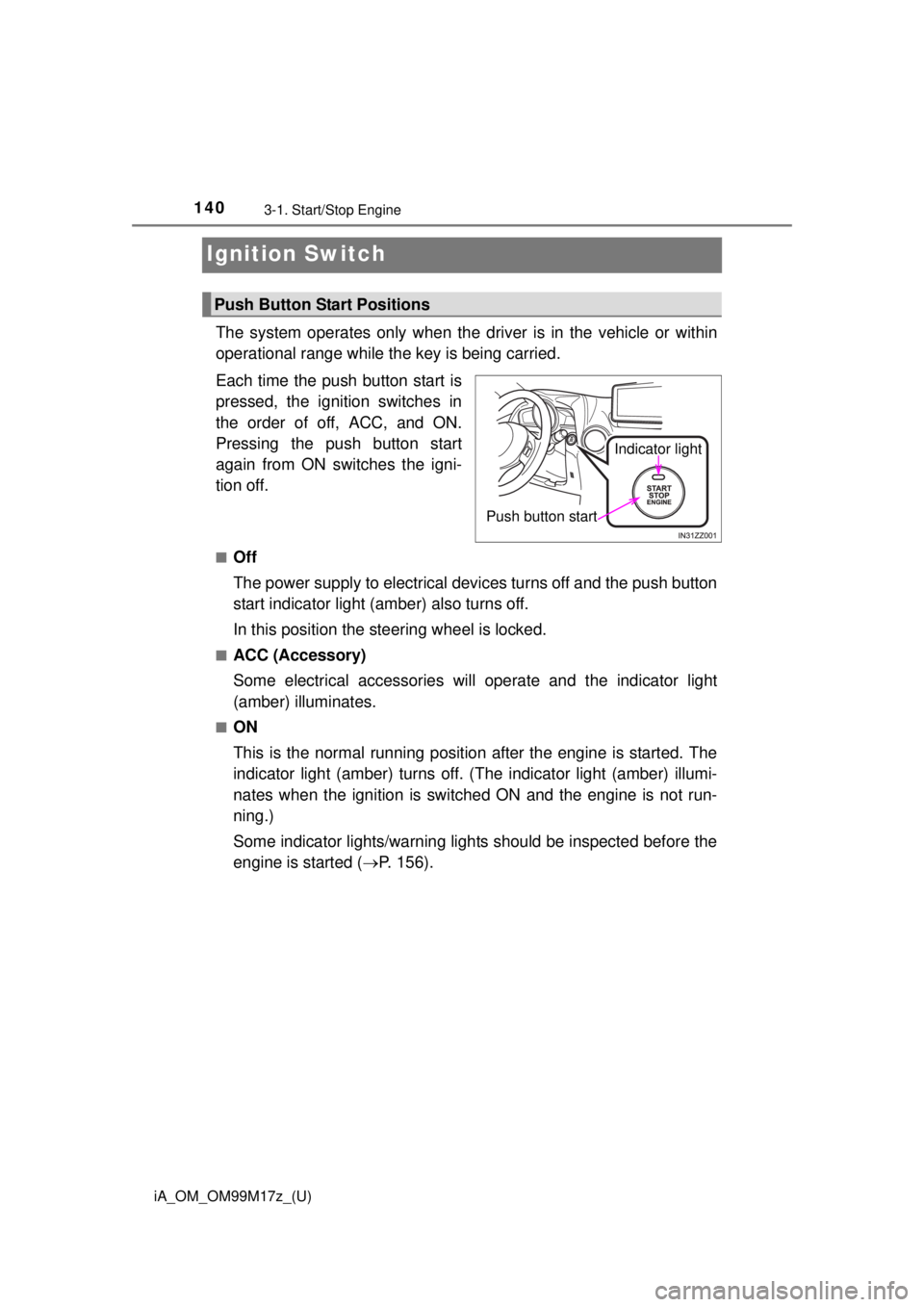
140
iA_OM_OM99M17z_(U)
3-1. Start/Stop Engine
Ignition Switch
The system operates only when the driver is in the vehicle or within
operational range while the key is being carried.
Each time the push button start is
pressed, the ignition switches in
the order of off, ACC, and ON.
Pressing the push button start
again from ON switches the igni-
tion off.
■Off
The power supply to electrical devices turns off and the push button
start indicator light (amber) also turns off.
In this position the steering wheel is locked.
■ACC (Accessory)
Some electrical accessories will operate and the indicator light
(amber) illuminates.
■ON
This is the normal running position after the engine is started. The
indicator light (amber) turns off. (The indicator light (amber) illumi-
nates when the ignition is switched ON and the engine is not run-
ning.)
Some indicator lights/warning lights should be inspected before the
engine is started ( P. 156).
Push Button Start Positions
Push button start Indicator light